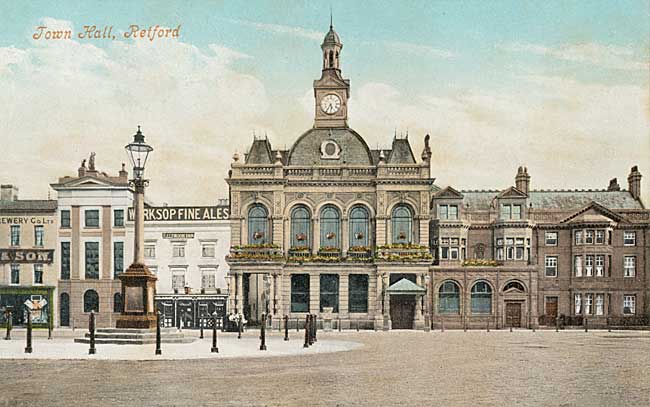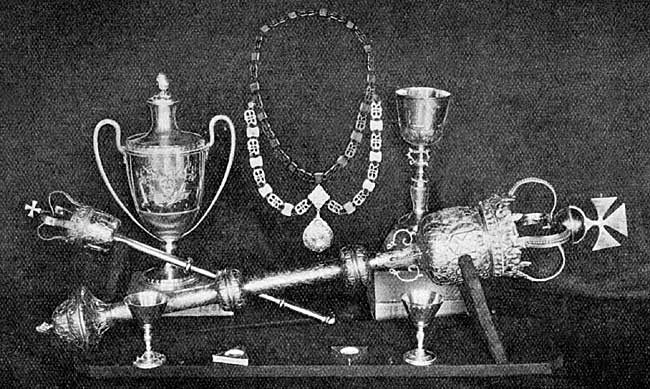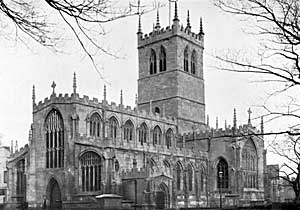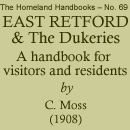< Previous | Contents | Next >
CHAPTER III.
SOME PERAMBULATIONS THROUGH THE TOWN, WITH DETAILS OF THE CHIEF FEATURES OF INTEREST.
(a) Round about the Market-place.

Town Hall, Retford c.1905.
VISITORS who have only an hour or two to spare will meet with features of interest in the centre of the town, namely in the Market-place or within a stone's throw of it. The most noticeable building is the Town Hall, (For admission, apply to the hall keeper who lives on the premises). The front is of stone elaborately carved. The entrance is lofty and spacious. At the end of it access is gained to the Market Hall. Ascending the grand staircase, attention is attracted by the mahogany tablet, "erected to commemorate the officers and men of the Sherwood Rangers Imperial Yeomanry, and Retford members of the Regular Army, Militia, and Volunteers who served in the South African Campaigns, 1899-1902," the inscription being followed by 270 names. The memorial was unveiled by Gen. Sir John French, K.C.B. on August 22nd, 1903. The book-case upon the landing between the large hall and the council-chamber contains the corporation library, musty volumes of value to the historian. The principal hall, 100 feet long and 40 feet wide, with the small gallery over the entrance, will accommodate 1,000 people, The council-chamber is a stately room, its windows looking out upon the Market-place. From the ceiling are suspended three three-armed chandeliers, one of six lights and two of three, all of the same design. Two, which were removed from the old hall, are said to be of the date 1800-1810, but the fact is curious that the second plate of Hogarth's "Marriage a la Mode" (temp. 1730), contains an exactly similar design. Upon the walls is a gallery of life-size portraits in massive gilt frames as follows:—
1. William III., b. 1650, m. Mary, d. of James II., 1677, reigned 1689-1702 ; after Sir Godfrey Kneller.
2. Mary II., d. of James II., Queen of William III.; after Kneller.
3. George II., grandfather of George III., b. 1683, reigned 1727-1760; believed to be by Shackleton, the gift of Viscount Galway.
4. Caroline of Brandenburg-Anspach, Queen Consort of George II., 1727-1737, m. 1705, at Herrenhausen, Hanover, said to be by Enoch Zimmer, also the gift of Viscount Galway.
5. Victoria, b. 24th May, 1819, reigned 1837-1901, by J. B. Kennington, inscribed:—"Her Most Gracious Majesty Victoria, Queen of Great Britain and Ireland, and Empress of India. In commemoration of her long, glorious, and beneficent reign. This portrait of Her Majesty is presented to the Town Council of East Retford by Alderman Denman, 1898."
6. Mr. John Smith, J.P., an Alderman of the borough, Mayor, 1864, 1865, 1867, 1868.
7. Mr. T. W. Denman, J.P., Town Councillor, 1866-1871, Alderman, 1878-1905, Mayor, 1883-1884; by Kennington.
The carved mantel-piece is understood to be the work of Grinling Gibbons. There are two busts: the one of marble nearest to the entrance is that of the fifth Duke of Newcastle, by W. G. Dewick (Retford). The other is that of the sixth Viscount Galway, who represented the borough in Parliament, 1847-1876.

The regalia, etc., of the Corporation of East Retford.
The mayoral chain is of solid gold, and of great beauty. It consists up to date of 26 links, each containing the name of the mayor for the year (the donor) with the date of his office, one link, of course, being added annually. The pendant thereto was the gilt of the present Lord High Steward of the borough.
There are two maces, each very fine, of silver gilded. The smaller one was presented to the corporation by Sir Gervase Clifton, Bart., M.P., who was elected Lord High Steward in 1616; and the larger was the gift of Sir Edward Nevile, Bart., of Grove, in 1679.
The following is a list of the corporation plate:— Presented by Sir Gervase Clifton (1620), silver cup (but of much earlier date), two small silver goblets, two triangular silver salt stands, and six silver spoons (the remainder of twelve). Presented by the Earl of Lincoln (1783), M.P. for the borough—large silver cup. And there are also the following:—silver punch ladle, with George II. coin (1743) inserted; two large china punch bowls, one of which contains silver rims (temp. George III.) top and bottom; and four silver salt stands.
Immediately in front of the Town Hall, in the Market Square, is the historic Broad Stone. It formerly occupied a slight eminence known by the name of Est-croc-sic, now called Dominie Cross. It is believed to have been the base of a cross, and to have formed one of four: a second is still preserved in the West Retford churchyard, a third was in the churchyard at Ordsall, the fourth is lost. These crosses are thought to have been fixed as the limit of a sanctuary, where the safety of offenders was granted, until the authorities could interfere. This, however, is doubtful: the possession of an ecclesiastical sanctuary was a high privilege, and the existence of one at Retford is improbable. More likely these crosses marked the boundary beyond which inhabitants smitten with the plague were prohibited to pass. Certain it is that at times the plague devastated Retford (especially West Retford in 1558). Our forefathers may have worshipped round the Broad Stone. When disease was prevalent the markets were held near it, in order that country people mighty not be deterred through fear of infection from bringing in their agricultural produce.
From Dominie Cross the Broad Stone was removed into the Market-place. It became the hustings where candidates for the two parliamentary seats allotted to this borough addressed their constituents, the freemen. Here, at various times, they were heckled, threatened, even assaulted. Woe betide the candidate who was not "all right." When 40 guineas were at stake it was serious to a freeman to "lose his election." Apprentices assembled here at the close of their "servitude" after a night's carousal and sang a ditty which is still preserved.

The Church of St Swithun, East Retford.
We now cross the Market-place to East Retford Church. [Open all the day]. This fine old church has a well-proportioned exterior, happily uninjured by its restorations from time to time. Its long history, its fine tower, its clerestory, its battlemented parapets with floriated pinnacles, and its carved work in harmonious design, invest it with an interest which is widespread. It is dedicated to St. Swithun, and was founded by Roger, Archbishop of York, in 1258. In the present volume, intended as a guide for visitors, it would be manifestly impossible to deal fully with its history, its benefactions and charities, its vicars and churchwardens, and other details, for which reference should be made to the History of East Retford Church, by Arthur A. Kidson, B.A.,LL.B (Lond.) recently published.
The church is cruciform. The nave is divided from the north and south aisles by arcades, each of four arches, springing from octagonal pillars with moulded bases and floriated capitals. In Piercy's day there were galleries, over both aisles, the west entrance, and south transept, all of which have been removed. The ancient font was restored in 1852, and in 1904 the mayor for the year gave a baptismal shell. The pulpit (by Place, the architect for the 1855 restoration) is octagonal, of Ancaster stone, rising from a square sub-storey, and supported on a carved and moulded semi-octagonal bracket with elaborate mouldings and carved leaves.
In 1855 the chancel was widened. The altar (with stone reredos) is raised on six steps. The clergy stalls (1899) are of oak, as are the choir stalls (1888), both from designs by C. Hodgson Fowler. On the south side is a small room formerly used as a vestry, with chamber above. The chantry of the Most Holy Trinity and St. Mary is separated from the chancel by an oak screen. It contains a picture of the Last Supper, by Mr. William Rose. The first organ was presented by Mr. Robert Sutton in 1770, and came from the theatre at Newark; a new one was built in 1795, which was replaced by a larger one in 1841, and that was practically rebuilt by Brindley and Foster in 1886.
The oldest monument (now in the chantry) is that of Mr. Smyth, mercer (1496). There is a memorial to Mr. Robert Sutton (1776), from which it appears that he gave £100 towards building the Town Hall, £100 towards Barnby Common Road, built Pelham Bridge (across the Idle on the Carr,* which was replaced in 1854 by the present bridge), and gave an organ and a bell to the church. There is also a memorial to Sir Wharton Amcotts, Kettlethorpe Park, (1807), who represented the borough in Parliament for twenty years. In the south transept is a tablet to the Rev. Richard Morton, M.A., vicar of the parish 49 years.
More than twenty stained glass windows have been put in since the middle of the last century. They vary in merit. The east and west windows contain excellent work, both in design and colour. A window in the south aisle (by Kempe), erected in memory of the Sherwood Rangers who fell in the South African War, was unveiled in December, 1903. The tablet below contains the following inscription:—"To the glory of God, and to the Memory of those of the Sherwood Rangers Imperial Yeomanry who died for their Sovereign and Country in South Africa, 1900-1902," and after the names: "This Window was dedicated by their friends.
' Not once or twice in our fair island-story,
This path of duty was the way to glory.' "
< Previous | Contents | Next >
* The Carr is here the name of a district or tract of land. According to Murray's Dictionary, the word has several meanings, all more or less related to water, and now visually denoting wet, boggy ground—ED.
